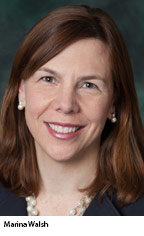
MBA: Mortgage Delinquencies Up, Foreclosures Down in 4Q National Delinquency Survey
Delinquency rates for mortgage loans rose in the fourth quarter after hitting 10-year lows the previous quarter, the Mortgage Bankers Association reported.
The MBA fourth quarter National Delinquency Survey said the delinquency rate for mortgage loans on one-to-four-unit residential properties increased to a seasonally adjusted rate of 4.80 percent of all loans outstanding. This represented an increase of 28 basis points from the third quarter and a three basis point increase from a year ago.
MBA noted, however, that foreclosure actions continued to drop. The survey said the percentage of loans on which foreclosure actions started during the fourth quarter fell to 0.28 percent, a decrease of two basis points from the third quarter and an eight basis points drop from one year ago. This represented the lowest rate of new foreclosures started since fourth quarter 1988.
The delinquency rate includes loans that are at least one payment past due but does not include loans in the process of foreclosure. The percentage of loans in the foreclosure process at the end of the fourth quarter fell to 1.53 percent, down two basis points from the third quarter and a 24 basis point drop from one year ago. This represented the lowest foreclosure inventory rate since second quarter 2007.
MBA reported the serious delinquency rate–the percentage of loans 90 days or more past due or in the process of foreclosure–rose to 3.13 percent, an increase of 17 basis points from the third quarter but a 31 basis point decrease from a year ago.
 MBA Vice President of Industry Analysis Marina Walsh noted the increase in delinquencies was broad-based across all loan types. “However, it should be noted that last quarter’s overall delinquency rate was at its lowest level since 2006,” she said. “It is not unexpected that delinquencies could eventually increase off such a low base. We continue to see strong fundamentals in the overall economy, such as rising home values and increased employment, which bodes well for the future performance of FHA, VA and conventional loans.”
MBA Vice President of Industry Analysis Marina Walsh noted the increase in delinquencies was broad-based across all loan types. “However, it should be noted that last quarter’s overall delinquency rate was at its lowest level since 2006,” she said. “It is not unexpected that delinquencies could eventually increase off such a low base. We continue to see strong fundamentals in the overall economy, such as rising home values and increased employment, which bodes well for the future performance of FHA, VA and conventional loans.”
MBA said the seasonally-adjusted FHA delinquency rate increased to 9.02 percent in the fourth quarter from 8.30 percent in the third quarter (its lowest level since 1997), driven primarily by the FHA 30-day delinquency category, which increased by 55 basis points over the quarter. “The increase in early stage FHA delinquencies was led by loans made in 2014, 2015 and 2016,” Walsh said. “However, on a year-over-year basis, there was no increase in the overall FHA delinquency rate.”
The report said the seasonally adjusted VA delinquency rate increased to 4.00 percent in the fourth quarter from 3.89 percent in the third quarter (its lowest level since 1979). On a year-over-year basis, the VA delinquency rate declined by 12 basis points.
The seasonally adjusted conventional delinquency rate increased to 4.04 percent in the fourth quarter from 3.76 percent in the third quarter. On a year-over-year basis, the conventional delinquency rate increased by 6 basis points.
MBA at the state level, 47 states and the District of Columbia saw no change or a decrease in foreclosure starts in the fourth quarter, while 22 states saw either no change or a decrease in loans in foreclosure. New Jersey and New York continued to see the highest percentage of loans in foreclosure, at 5.42 percent and 4.28 percent, respectively, but also continued to show improvement from the previous quarter.
The NDS, conducted since 1953, covers 38 million loans on one- to four- unit residential properties. Loans surveyed were reported by more than 100 lenders, including mortgage bank, commercial banks and thrifts.
